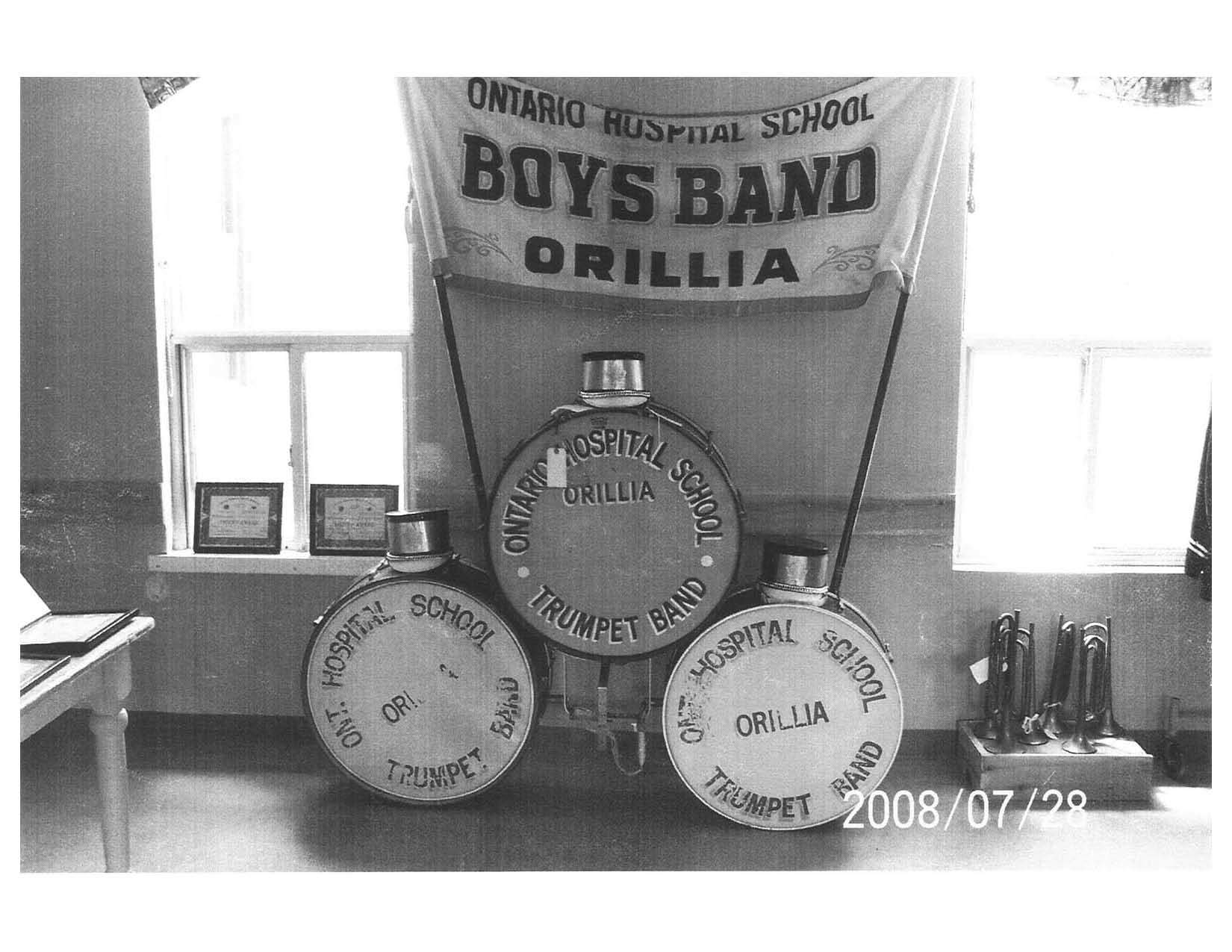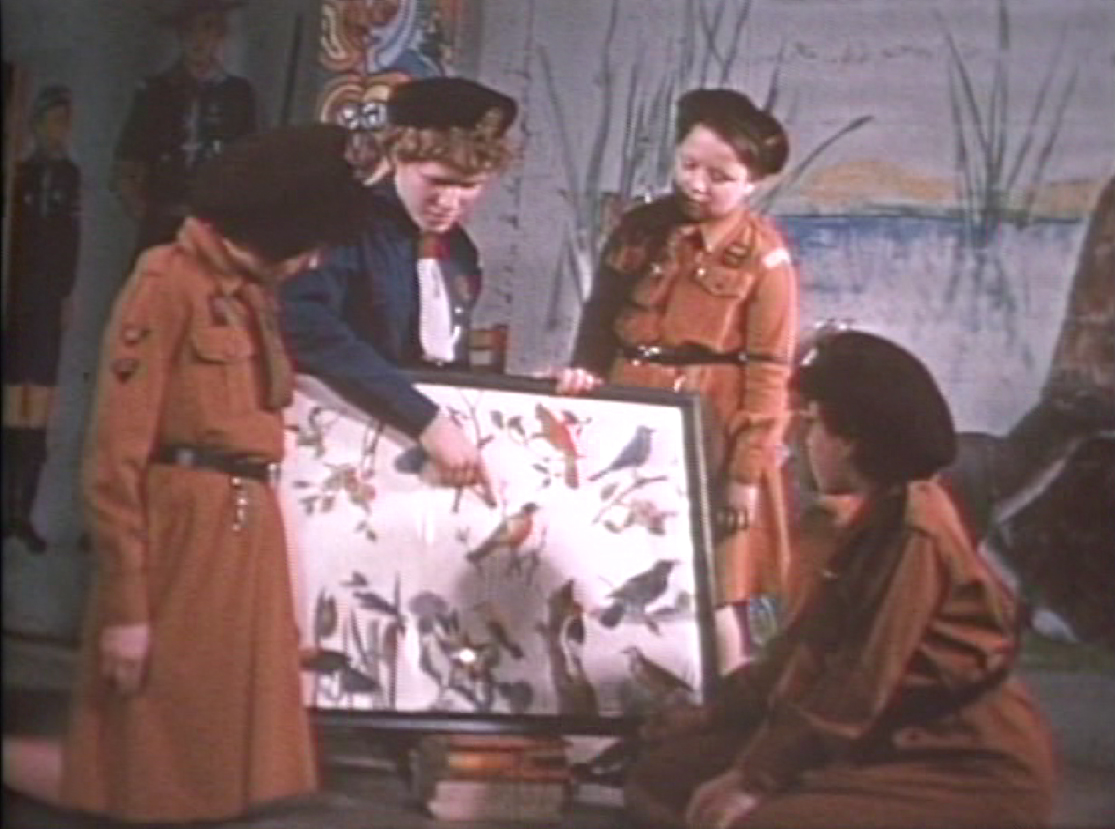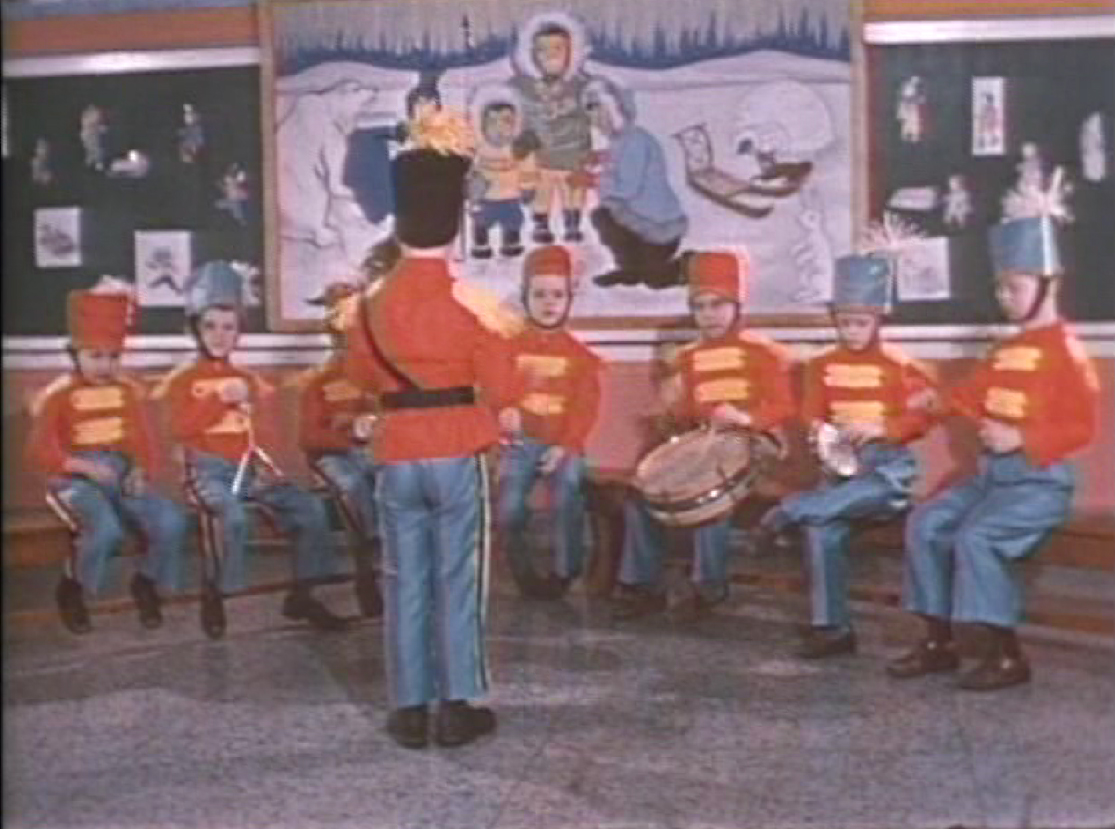Sexual Abuse at Huronia
As may well be imagined in overcrowded and understaffed conditions, sexual abuse was common. Some attendants took young boys down to small rooms and recesses off the tunnels (called “tram-ways”) in the basement and “played with them”, sexually abusing and sodomizing them, recalls former patient Desi Harnum. After the 1976 Willard Report, the recesses were ordered to be filled in.
Another survivor, Barry Thatchuk, recalls having to perform oral sex as a boy on a night attendant after he had used the washroom, and then being sexually abused (sodomized) by him. (See Institutional Survivors’ Stories and And Neither Have I Wings To Fly.)
The attitude of attendants towards masturbation varied. Some punished patients by strapping their hands with a razor strop. Others were permissive and encouraged the practice in the communal showers, turning a blind eye.
Female patients were also abused by attendants. Desi Harnum, a patient at Ontario Hospital School from age three, recalls attendants having sex with girls down by the lake on the Thursday cook-outs, and threatening them not to report it. A popular threat was to swing a girl upside down as a warning.
The Willard Report 1976
Male attendants often had access to female patients. The Willard Report noted complaints of parents that “male staff were bathing adult female residents.” However, this continued well into the 1980s and 1990s. -
Sexual abuse was not limited to male attendants. Male Survivors interviewed recall female as well as male attendants squeezing boys’ genitals while they stood lined up in the dorms for early morning inspection.
We will never know the full extent of sexual abuse suffered by young patients who were too vulnerable and intimidated to protect themselves or protest.
Physical and Psychological Humiliation
While punishment was painful, all survivors interviewed stressed that the worst thing was the psychological hurt and shame felt when attendants ridiculed them, calling them “retards”. This was constant and endemic.
Lack of privacy and general neglect was another important factor in the physical-psychological abuse of patients, particularly in toileting, bathing, and undressing. Patients lined up to shower and showered under communal shower-heads. Bathrooms had no doors, showers no curtains.
Communal Showerheads. Photo: Thelma Wheatley.
Filthy rows of toilets faced rows of wash-basins. A former staff worker related that she worked at Huronia in the 1980s and was shocked that old men were showered in groups, with female attendants hosing them down “to save time and effort.” Girls in particular felt humiliation at having to undress in front of others and line up naked for the showers.
“The toilets face the washbasins and here as elsewhere, there is no attempt at privacy. I had nearly said decency.” - Government Inspector Dr Fletcher’s report,1932, of Cottage “A”.
Menstruation: Again, girls were given no privacy. A girl had to stand up after breakfast and, in front of everyone, announce that it was day one of her menstruation. This was recorded by staff and she was allotted kotex pads for the day. An intimate record was kept of number of days and flow of blood. If a girl did not menstruate around the expected date, she was sent to the infirmary to be examined in case she was pregnant. (After the advent of contraceptive pills in the 1960s, girls were forced to take the drugs to eliminate the bother of menstruation and prevent pregnancy.)
In 1960, Pierre Berton from the Toronto Daily Star, visited the institution and reported almost identical conditions, citing that in one cottage there was one bathtub for 144 persons.
Anne Stafford, former Community Living member and volunteer at the institution to help individual children, recalls pushing her way with some parents into Cottage “D” (Boys) in the early 1960s demanding to see conditions. They were shocked to find that the shower area consisted of two bare brick walls between which the boys were hosed down with one hose-pipe.
Yet despite the scathing criticisms of their own inspectors over the decades, and the admission of Dr Matthew Dymond, Minister of Health in 1960 of overcrowding and neglect, the government of Ontario did little to assuage conditions. Cottage “B” and “L” were torn down following Pierre Berton’s report, and a new building erected, the McGhie Pavilion, with more private quarters.
Sterilization, Drugging and Medications
Sterilization Consent Form signed by parents, Province of Alberta. Courtesy Archives of Ontario.
The words on the form say:
“I (we) the (parents) of (name of patient) who is at present in (name of institution) at (place), Alberta, hereby give consent to the performance of an operation for sexual sterilization on (name of patient), the said (name of patient) will be unable to procreate children.
I (we) have given consent to this operation voluntarily, after due consideration, and without promises, threat, or coercion of any kind.”
Sterilization in Ontario: Ontario never passed a Sterilization Act to eugenically sterilize people with intellectual disability, unlike the Province of Alberta, which passed a Sterilization Act in 1928, and British Columbia in 1932.
However, superintendents at the Orillia institution and other institutions were well aware of the aims of Canadian eugenicists who petitioned Premier Mitchell Hepburn of Ontario to pass such an act during the 1930s. While Superintendent Dr Bernard McGhie at Orillia was against the sterilization of all mental defectives, claiming it would do little to reduce mental retardation, his successor, Dr Horne, was more ambivalent.
In a letter to Dr Atkinson, the Medical Superintendent of the Manitoba institution, Portage La Prairie, in 1935, Horne inferred that sterilizations were done “on the quiet” in Ontario
Chemical Sterilization of Females
Another more insidious form of sterilization was the use of Depo Provera as a contraceptive in the institutions. It was used to suppress menstruation and control fertility in intellectually disabled women without their informed consent. It had been refused licensing in the United States as there were reported side-effects linking it to cancer. However, in Canadian institutions, including Huronia, women were forced to take the drug not knowing what it was, in violation of their legal and human rights. Using the drug to control fertility and menstruation contravened the provisions under which the drug was licensed in Canada. In 1985, the Canadian Association for Community Living formed a Coalition on Depo Provera and met with the Minister of Health and Welfare to discuss safety issues of the drug and the abuse of their human rights of giving the drug to women without their informed consent. Again, in 1988, the Association along with other coalitions tried to counter the Department of Health and Welfare which intended to license Depo Provera.
Drugging Patients
The Willard Report of 1976 devoted a section to “Medication”, citing parents’ complaints that “too much medication was being given to residents.”
“At a meeting with representatives of the Ontario Association for the Mentally Retarded (OAMR) it was suggested that on the basis of statistical data, the volume of medication being prescribed at mental retardation centres was high. There is concern about the detrimental effects over time as well as adverse short term side effects that may result from tranquilizing, anti-convulsant and other agents.” (Willard Report, p. 107).
The matter was discussed with medical staff, the Chief of Pharmacy, and a number of counsellors at Huronia Regional Centre. While medical staff and counsellors did not consider this a problem, it is interesting that the Pharmacist “indicated that a very large volume of drugs was being used at the Huronia Regional Centre.”
As a result, a Drug Utilization and Control Committee reported that various surveys indicated that there was:
“a problem of misuse as it relates to excessive use of psychopharmological agents, polypharmacy in the area of anti-convulsive control, and inadequate use of certain psychopharmological agents, for example, lithium. Epileptics on multiple anticonvulsant and tranquilizing agents were irritable and difficult to manage. A team of three psychiatrists in July 1976 felt that this irritability “may well be the result of toxicity from the medication.” (Willard Report, p. 109.)
Gail Lynam’s patient records showed that she was put on 75mg of a powerful anti-psychotic medication, Mellaril, for supposed “homosexuality” at age sixteen.
Guinea-pigs
Prof. Harvey G. Simmons, in his book From Asylum To Welfare, (Downsview: National Institute on Mental Retardation, 1982) writes that there was evidence that under J. Downey’s superintendency Orillia residents were used by the Connaught Laboratories in Toronto to test new drugs. In his report for 1925, Mr Downey noted that Orillia residents had suffered several epidemics. The Connaught Laboratories were called as they were investigating the Dick test and scarlet fever anti-toxin. One thousand and eighty tests were made on patients, with 297 positive reactions to which the experimental immunization was then applied. Simmons notes that Downey did not say whether the parents of the inmates were consulted. By contrast, when a diphtheria toxoid test was made of Toronto school children in December, 1926, parents were first asked to give their written consent.
Patient Labour
Patients were to be educated and trained to perform tasks and labour that would make the institution self-sufficient so as “not to be a drain on the public purse”, as Dr MacMurchy, Inspector for the Feeble-Minded in Ontario 1905-1920, urged.
High Grades and Low Grades
New admissions were divided into two main groups: the “High Grades”, with above 50 IQ, who were ambulatory and could work and contribute to the economy of the institution. They were the most important group and highly desirable.
The group with below 50 IQ were labelled “Low Grades”, and though many of them might be able to perform low-grade work such as shovelling coal, many were unable to work at all, and needed the support of others, such as the “High Grade” patients and regular staff.
A constant complaint of superintendents over the decades was that there were never enough “High Grade” patients to do the work and ease staffing. The High Grade patients did the work of hired staff, thus relieving the cost of wages since their labour was unpaid. Though on the surface it appeared that they were receiving “vocational” and “occupational” training which might enable them to work outside in the community, a close look at their labour shows many patients working long hours, a regular working man’s day outside in the community.
Boys and Men: Labour
Farm Labour: This was an important aspect of the economy of Orillia. On the surface it would appear that the farm boys had a healthy enjoyable life working in the fields planting crops and harvesting, and working in the barns with the dairy herd, and in the hoggery. In 1936 and into the 1940s, there were 96 head of cattle, with a daily milk production of 2,500 pounds, 131 swine and 13 sows, and 1000 chicks with 90% survival.
Orillia institution farm, today the site of the OPP. Photo courtesy Archives of Ontario.
The “farm boys” lived segregated from the main population in the institution, in Cottage “F”. Boys were shaken out of bed at two-thirty in the morning for milking at three am. with breakfast served not until eight am.
Out in the fields, boys worked long hours working alongside hired labourers. In 1935 they harvested 550 bushels of oats, at 35cents a bushel, that brought in $192.50. They also harvested 3,000 bushels of mangels at 10cents a bushel, bringing in $300 for the farm.
A medical inspection by Dr J. Sharpe, government inspector, in 1937, gives a revealing picture of life for the farm boys:
Dunn Farm, Cottage “F” (also called Farm Colony House): Farm colony house, ½ mile from the hospital. Quiet older parole type patient, resides 23 males there, have main meals in Cottage “C”. Supervised day and night by attendant. House in poor condition – Floors bad – some of the windows are out, verandah falling down. In the attic you can see daylight through the walls. Toilet poor in a shed, therefore impractical to use in winter. Lease expires June 30th, 1937.
Farm labour continued well into the 1960s. Survivor Desi Harnum recalls that in helping out with the pigs boys were treated “like pigs”.
Shoemaking at Huronia. Photo courtesy Archives of Ontario.
Shoemaking Shop: Boys and men also provided good income for the institution in shoe-making. Under Mr Downey’s superintendency in the 1920s and 1930s, boys turned out up to 30 pairs of shoes a day, as well as all grades of work boots and walking shoes for the girls. This industry in 1932 brought in $14,802 for 305 dozen pairs of shoes and in 1941 sales were valued at $10,425.
Tailor Shop: Another productive source of income for the institution using patients’ free labour. Boys not only made clothes for patients such as shirts, smocks, caps and staff uniforms, but they filled orders from other institutions. Tweeds made by patients in Guelph Reformatory were used to make clothing at Orillia.
Furniture Repair Shop: ‘High Grade’ boys helped repair furniture, while ‘Low Grades’ did sanding and varnishing.
Night Monitors: 'High Grade' older boys and men were often used to as night monitors in the wards, locked in with the patients. These men had to work by day at various jobs and do the supervision of staff when staff were not available, at night. Inspectors disapproved of this practice, but the institution was short-staffed.
‘Low-Grade’ Boys’ Labour: Boys and men deemed “low grade” in intelligence, or “Imbeciles”, were nevertheless put to work, doing physical labour around the institution, such as shoveling coal in the “coal piles”, berry-picking, removing sludge from drains, draining marshes, snow shoveling.
Girls and Women: Labour
Ward Work: “Low Grade” girls were assigned “Ward Work”, which included washing and scrubbing institution floors in wards, hall-ways and the nurses’ residence, cleaning out slop pails in the old women’s residence, cleaning up urine, blood and feces of other patients, gathering up soiled laundry.
They also served in the dining rooms, helped out in the kitchens preparing food, cooking, cleaning, setting up trays. Sometimes girls got burned on the hot steam pipes in the kitchens.
Dining Room and Kitchen: They also served in the dining rooms, helped out in the kitchens preparing food, cooking, cleaning, setting up trays. Sometimes girls got burned on the hot steam pipes in the kitchens.
Laundry: Patients did 28,000 pieces of laundry per week. Boys and men helped out at the laundry as well as girls, because the wet sheets in the machines were too heavy to be lifted out by girls. Patients did 1,200 sheets and articles of clothing per week.
Helping the Nurses’ Aides: Girls helped look after the babies and young children, again doing menial tasks such as changing diapers, cleaning up. Gail Lynam, former patient, recalls in the 1960s having to help with the babies suffering from hydro-cephalus on the children’s wards, and how heavy the infants were to carry on account of their heavy enlarged heads. She was only a young girl of about thirteen herself at the time. (See: And Neither Have I Wings To Fly.)
Girls were also used to help look after old women in Cottage “L”, for instance, helping change their diapers and clothes, bathe them or hose them down, feed them from side trays.
Sewing Class: From the 1930s onwards up into the 1970s and 80s, sewing was an important part of self-sufficiency in the institution economy. Girls and women sewed most of the clothes worn by patients, such as underwear, dresses, pleated skirts, middies, blouses, smocks, pantie suits, ties, nightgowns, bath-robes, nurses’ uniforms, as well as sheets, pillow-cases, towels, aprons, curtains, mattress covers; also socks knitted on the auto-knitter. They even made their own straight-jackets!
Domestics on Probation: Many girls and women in the institution were of normal intelligence. Along with the “high grades”, those with an IQ above 50, they were trained as domestics and allowed out on probation under strict supervision, living in Colony House, a home in the town of Orillia. They were employed as domestics in citizens’ homes in town, working from eight in the morning to six at night. They kept half their wages, banked for them in accounts, and the other half went to the institution.
Dr Horne, Superintendent, in the 1930s, reported that the per capita cost of maintaining each girl out on probation at Colony House had been 75 cents per day compared with 86 cents per day for residents in the hospital, giving the institution a small profit. Employing girls as domestics in the town continued into the 1970s and 80s.
Kitchen work. Photo courtesy Archives of Ontario.
Girls in laundry. Photo courtesy Archives of Ontario.
Baby suffering from hydro-cephalus.
Girls and women sewing. Photo courtesy Archives of Ontario.
Sewing. Photo courtesy Archives of Ontario.
School and Recreation
Slideshow photos courtesy Archives of Ontario.










